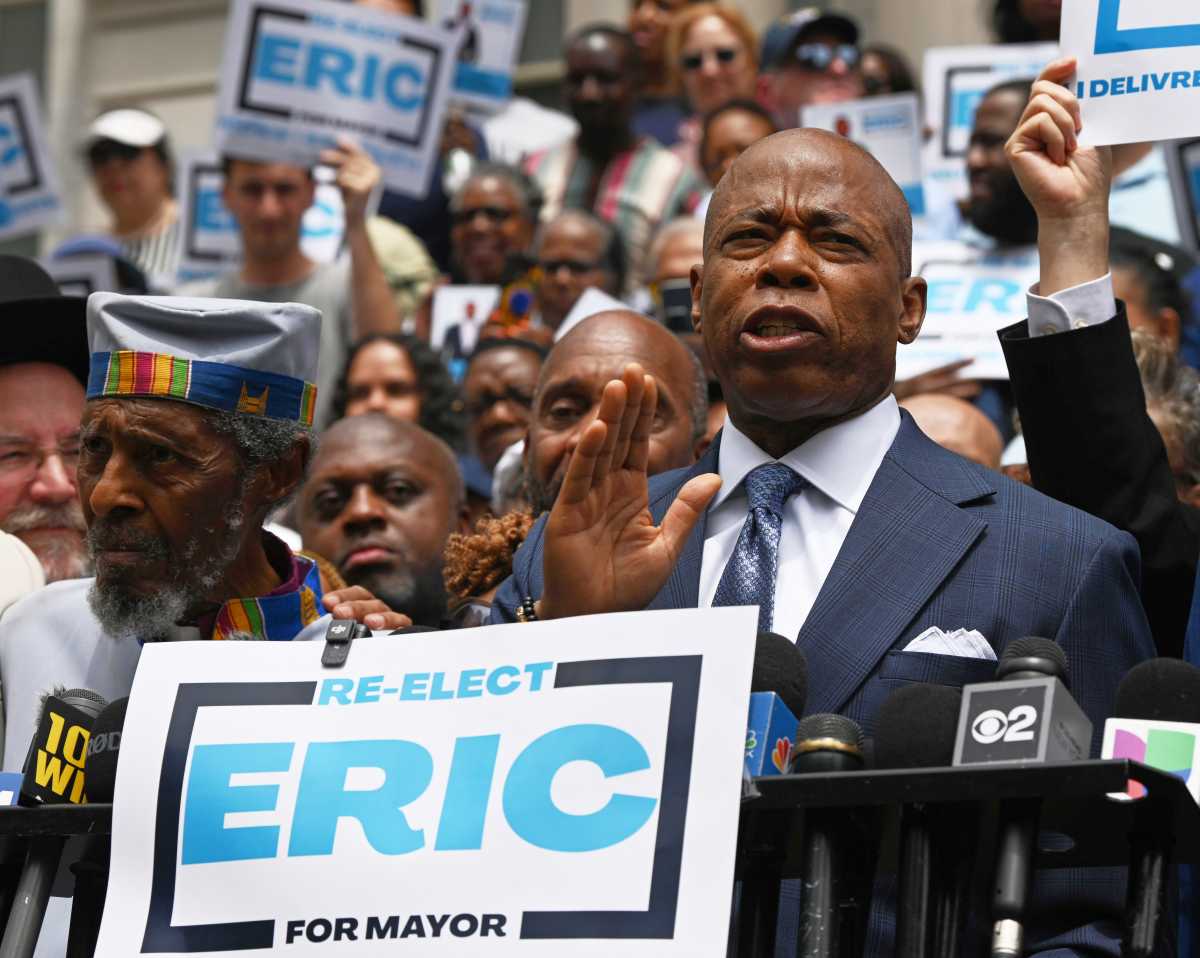Mike Leonardos has been serving hot coffee and two-egg specials at the
Silver Spoon diner on Flatbush Avenue for more than 20 years.
The eatery sits just across the avenue from where real estate mogul Bruce
Ratner plans to build a 19,000-seat basketball arena for his recently
purchased Nets, an arena he’d surround with office towers and, down
the line, residential ones. Gov. George Pataki, Mayor Michael Bloomberg
and Borough President Marty Markowitz have all championed Ratner’s
plan.
So while pictures of Markowitz and former Mayor Rudolph Giuliani grace
the walls of his restaurant, Mike says these days he’s had it up
to here with politicians.
“This is a tricky deal,” Leonardos said, looking up at a photograph
of Markowitz, whose idea it was to bring professional basketball to Brooklyn.
Leonardos owns the diner along with his brother Paul, and doesn’t
think an arena would do anything for his business.
“They’re going to have a train station right beneath it, nobody’s
gong to come here,” he said of the Atlantic Terminal transit hub
that would likely be connected to the arena underground.
While the Silver Spoon would not be torn down to build the arena, just
across the street, and for about three blocks into Prospect Heights, approximately
500 residents and businesses would not be so lucky.
In order to construct the sweeping Atlantic Yards project, named for the
Long Island Rail Road yards upon which about half of the 21-acre project
would be built, Ratner plans to ask the state to use its powers of eminent
domain to raze nearly three square blocks of private land.
“I’ve been here since ’80 — it’s like my hometown,”
Leonardos said of the neighborhood, adding that he did not want to see
his friends lose their homes and businesses.
Ratner has vowed to fairly compensate property owners and relocate displaced
renters, although under eminent domain he only has to pay appraised value,
which would be lower than market value. But renters face much more uncertainty
since the state does not guarantee any relocation assistance, according
to Michael Rikon, an eminent domain attorney.
Among the ranks of the displaced would be famed sculptor Louise Bourgeois,
noted violin maker Sam Zygmuntowicz, two luxury condominium buildings,
two homeless shelters that neighborhood activists and elected officials
fought to keep out of the area, a beloved Prohibition-era bar, and a Holocaust
survivor who recently lost her husband and doesn’t know if she can
endure another move alone.
Included among them is Joseph Pastore, who several neighbors described
as “a real Brooklyn character.” Each day, Pastore puts on his
black cap and walks the blocks of Prospect Heights, chatting with neighbors
and picking up old cameras, records and household items that others have
cast away.
Since 1967, Pastore has lived in a small, rent-stabilized studio apartment
along Dean Street between Flatbush and Sixth avenues.
Raised in a number of orphanages, including the St. Vincent’s Home
nearby, Pastore, 59, considers Dean Street his true home. Talking to a
reporter outside, he can’t go more than a few minutes without greeting
a neighbor.
“This is my neighborhood, and it’s a beautiful neighborhood,”
said Pastore, standing outside the four-story, painted-yellow brick building.
“I was raised as an orphan all my life, so whatever I did it was
all on my own,” he said. “Don’t get me wrong, I had friends.
I was raised with 270 kids.
“I have close friends like brothers, just like Ratner and Pataki,”
Pastore said, noting with a hint of sarcasm the friendship between the
developer and governor, who attended Columbia Law School together.
Now Ratner is counting on his old friend to condemn that block of Dean
Street as if it was blighted, so he can build a sports complex and office
towers. When asked what he would do if he lost his $400-a-month apartment,
Pastore, a former youth counselor who lives on a fixed income, said he
did not know.
And he isn’t alone.
Just behind Pastore’s apartment building stands the Atlantic Art
building, a 31-unit, luxury condominium at 636 Pacific St. with apartments
selling for between $400,000 and $1.4 million.
With favorable reviews, like one in a British design magazine that lauded
its urban design and art deco touches, the converted warehouse isn’t
what most people would call urban blight.
Less than a year ago, Daniel Goldstein and his fiance, Echo Eggebrecht,
purchased a 1,300-square-foot, three-bedroom apartment on the seventh
floor.
Looking out at the sweeping views of Brooklyn, with the Verrazano Narrows
Bridge in the distance, Goldstein, who spent five years looking for a
place to buy, says he can’t believe he may have to leave the apartment.
“It’s the first home we’re making together and we intended
to keep it for a long, long time,” said Goldstein, a 34-year-old
graphic artist who works out of his apartment. Eggebrecht has an art studio
in the apartment.
Both Eggebrecht and Goldstein, who says he is optimistic about their chances
of fighting the plan, have joined with Develop Don’t Destroy, a group
of tenants and owners in the area who are fighting the Ratner plan. They
have retained an attorney, Jack Lester, who has represented several groups
of Manhattan residents fighting quality-of-life problems.
While planning a wedding is normally stressful, Goldstein says it is infinitely
compounded by the threat of losing your home. He said the ordeal had even
put a stress on the couple’s relationship as they plan their May
wedding, set for the Brooklyn Botanic Garden.
“I may be the minority on this, but I like the tracks, I like the
rugged urban feel of the neighborhood,” said Goldstein, looking out
his window at the railroad tracks and the traffic making its way, slowly,
down Flatbush Avenue.
Just to the south of the tracks is a Mobil gas station, one of the first
in the city to offer a compressed natural gas filling station.
“This is a neighborhood business,” said John Tsao, who has owned
the gas station for 25 years.
If Atlantic Yards gets the green light, the Mobil station will be razed.
According to site plans, it stands approximately where arena bathrooms
would go.
As Tsao takes a break from working in the auto shop, he chats about the
demerits of microwaves with a customer buying a cup of tea in the gas
stations mini-mart.
He greets neighbors by first name.
If he is forced to close his business, Tsao, a Brooklyn native who lives
in Park Slope and attended Brooklyn Technical High School, just a few
blocks away, said he did not know what he would do.
“I’ll be lost,” he said, explaining that he has a home
mortgage to pay and two kids in college. Not to mention eight employees
who will be out of jobs.
Watching taxi cabs fuel up on their way back to Manhattan, Tsao sighed
and said, “It’s a shame that after spending a lifetime in Brooklyn
they can come in and tell you to take a hike.”

























